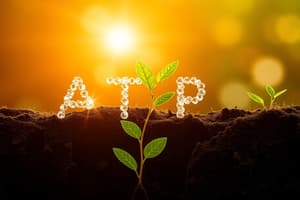Podcast
Questions and Answers
Why is ATP useful to cells?
Why is ATP useful to cells?
ATP can easily release and store energy by breaking and re-forming the bonds between its phosphate groups.
What happens during the process of photosynthesis?
What happens during the process of photosynthesis?
Plants convert the energy of sunlight into chemical energy stored in the bonds of carbohydrates.
What is ATP?
What is ATP?
One of the most important compounds that cells use to store and release energy.
What are heterotrophs?
What are heterotrophs?
What are autotrophs?
What are autotrophs?
What is photosynthesis?
What is photosynthesis?
What role do pigments play in the process of photosynthesis?
What role do pigments play in the process of photosynthesis?
What are electron carrier molecules?
What are electron carrier molecules?
Photosynthesis uses the energy of sunlight to convert water and carbon dioxide (reactants) into _____ and _____.
Photosynthesis uses the energy of sunlight to convert water and carbon dioxide (reactants) into _____ and _____.
What are pigments?
What are pigments?
What is chlorophyll?
What is chlorophyll?
What are thylakoids?
What are thylakoids?
What is stroma?
What is stroma?
What is NADP+?
What is NADP+?
What are light-dependent reactions?
What are light-dependent reactions?
What are light-independent reactions?
What are light-independent reactions?
What happens during light-dependent reactions?
What happens during light-dependent reactions?
What happens during light-independent reactions?
What happens during light-independent reactions?
What factors affect photosynthesis?
What factors affect photosynthesis?
What are photosystems?
What are photosystems?
What is the electron transport chain?
What is the electron transport chain?
What is ATP Synthase?
What is ATP Synthase?
What is the Calvin Cycle?
What is the Calvin Cycle?
Flashcards are hidden until you start studying
Study Notes
Photosynthesis Overview
- ATP is a vital energy currency for cells, capable of easily releasing and storing energy through the manipulation of phosphate group bonds.
- Photosynthesis converts sunlight energy into chemical energy in the form of carbohydrates, allowing plants to create food.
Key Terminology
- ATP: Primary compound for energy storage and release in cells.
- Heterotrophs: Organisms that obtain food by consuming other living beings.
- Autotrophs: Organisms that synthesize their own food using sunlight or inorganic materials.
- Photosynthesis: Process in which autotrophs use sunlight to produce high-energy carbohydrates such as sugars and starches.
Role of Pigments
- Pigments in photosynthetic organisms absorb sunlight energy to facilitate photosynthesis.
- Chlorophyll: Principal pigment in plants responsible for capturing light energy.
Photosynthesis Process
- Reactants: Water and carbon dioxide are converted using sunlight energy.
- Products: High-energy sugars and oxygen are produced during the process.
Photosynthesis Structure
- Thylakoids: Sac-like structures where light-dependent reactions occur.
- Stroma: Fluid component surrounding thylakoids in chloroplasts.
Electron Transport and Energy Carriers
- NADP+: An electron carrier that accepts high-energy electrons and hydrogen ions.
- Electron Transport Chain: Series of proteins that transfer high-energy electrons to generate ATP.
Types of Reactions
- Light-dependent reactions: Utilize light energy to produce oxygen, ATP, and NADPH.
- Light-independent reactions (Calvin Cycle): Utilize ATP and NADPH to convert carbon dioxide into high-energy sugars.
Factors Impacting Photosynthesis
- Key factors influencing photosynthesis include temperature, light intensity, and the availability of water.
- Photosystems consist of clusters of chlorophyll and proteins that facilitate the absorption of light.
ATP Production
- ATP Synthase: Enzyme that enables H+ ions to move across the membrane, generating ATP during photosynthesis.
Importance of the Calvin Cycle
- The Calvin Cycle utilizes energy from ATP and NADPH to create stable high-energy carbohydrate compounds, which can be stored for long-term energy needs.
Studying That Suits You
Use AI to generate personalized quizzes and flashcards to suit your learning preferences.




